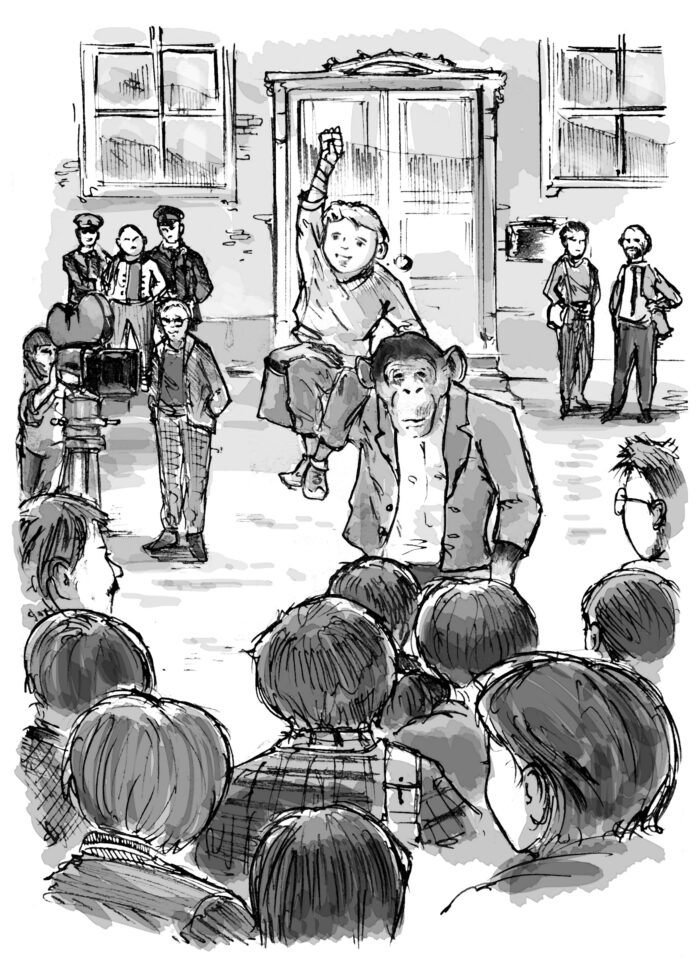Uncategorized
About the book and its author
Adam the Ape was first published in 2016 in the German language under the title Adam der Affe. The author, Wolfgang Wambach, was born in Koblenz, Germany, in 1975.
Wambach graduated with distinction from the Art Academy of Kassel, Germany, with a degree in visual communication. He worked in the television and film industry and won several awards, one of them for Best Cinematography in Almería, Spain.
Several years later, simply observing through the camera was not enough for him anymore—he chose to make a name for himself by creating his own stories. Wambach’s books are always optimistic and they center on philosophy, science, and life in the twenty-first century.
Wambach lives near Cologne, Germany, and is happily married to his wife. They have a daughter and a son, who inspire his writing every day.
He can be contacted by email at info🐒 wolfgangwambach.de

Reviews
- The American Humanist Association reviews “Adam the Ape” and writes that it “inspires young readers to question what they know about people, animals, and justice—strengthening their critical thinking and emotional intelligence. They learn that we all have the power and responsibility to reduce harm, speak up for, and listen to others”
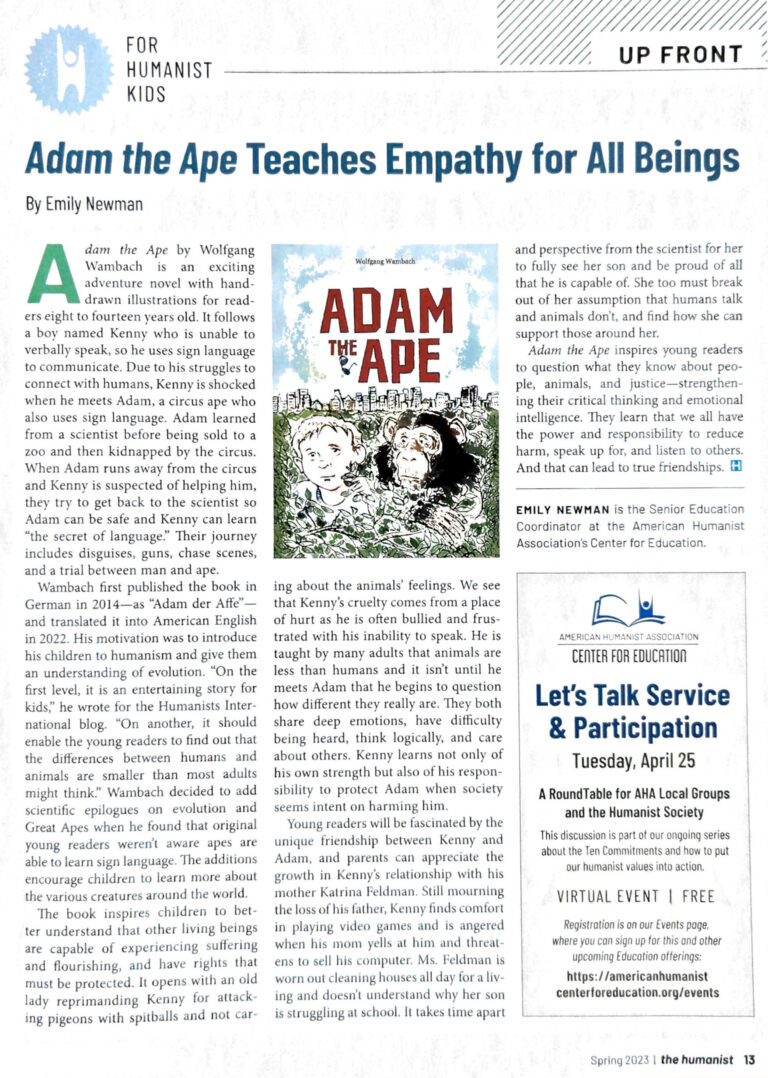
- Secular news website Only Sky reviews “Adam the Ape” and says it’s “an adventure story for kids, rooted in animal rights and evolution.”
- The Richard Dawkins Foundation of Germany interviews the author about the children’s book, judging it is “full of suspense” and “well done.”
- The Humanist Press Agency of Germany, Austria and Switzerland reports about the book, saying it is “very well done.”
- Child psychologist Ron Crouch, a.k.a. “Dr. Dad“, read the book with his son: “This is a great book for boys and girls ages 8 to 14.”
- The German newspaper Rhein-Zeitung reports about a reading contest in an elementary school:

- The Great Ape Project highly recommends the book:
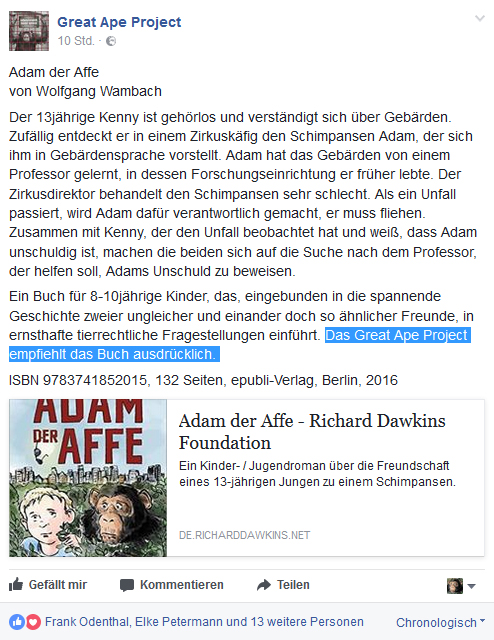
- The Jane Goodall Institute of Germany recommends the book.
- Irish secondary school kid Aideen Hamill compared “Adam the Ape” with Richard Dawkins’ “Outgrowing God” for Atheist Ireland.
- The German skeptic website for families with children susannchen.info recommends the book and interviews its author.

- The German skeptic magazine Skeptiker presents the book:
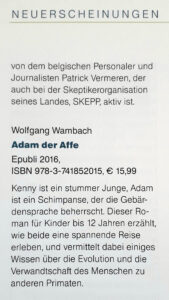
- The Austrian website gebaerdenwelt.tv presents the book in a video report in sign language:

- The Austrian magazine for the sign language society GebärdenSache presents the book:
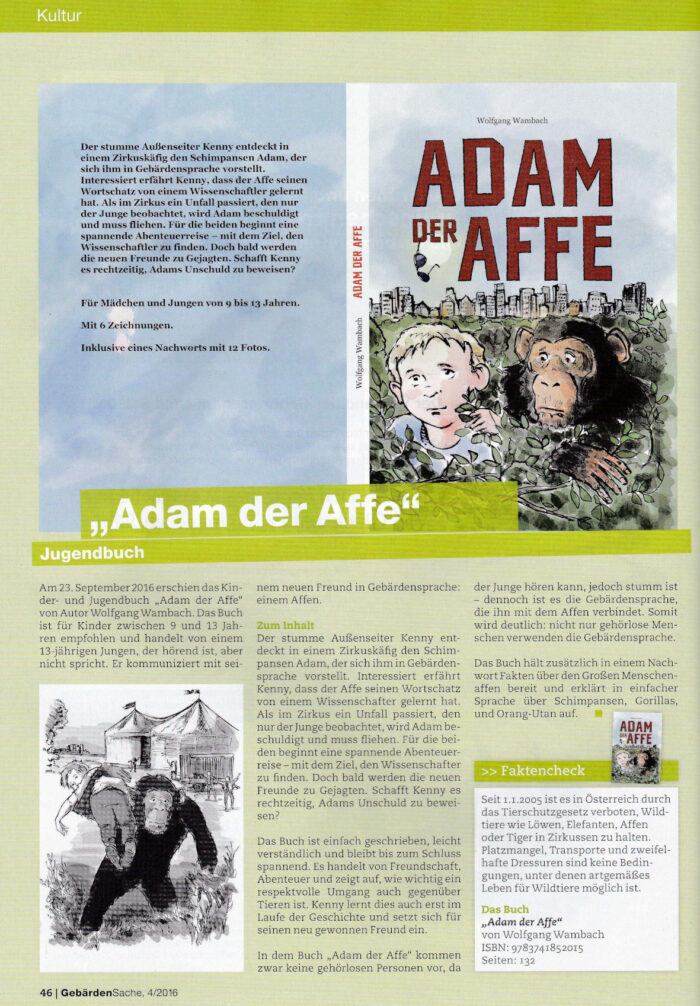
Epilogue about evolution
Adam the Ape has a scientific epilogue, which explains the theory of evolution for young readers. Here is an excerpt:
Charles Darwin (1809–1882) is the most widely known scientist to recognize the relationship between humans and animals. He was one of the founders of the theory of evolution, which states that all living things—animals and plants—are related and that they developed from other creatures over many generations. Living things adapt to their surroundings and slowly develop into different creatures over time. Their adaptations are caused by chance changes, called mutations, that help those living things survive in particular surroundings.
For instance, some bear species have lighter fur, and some have darker. Polar bears have developed white fur as an adaptation to their snowy landscape. It helps them to better camouflage themselves and hunt their prey. If brown bears lived in a polar area, they would be much more visible to prey and less successful at hunting. They would be more likely to die of hunger, leaving fewer descendants and leading to extinction in that region.
For a bear living in a snowy region, having white fur is the best trait for survival. This process is called the struggle for life, which leads to natural selection, or the best-adapted creatures surviving.
Different kinds of creatures who all share a common ancestor develop differently in different surroundings. This occurs after countless generations experiencing countless slight adaptations. Some people don’t accept the scientific principle of animals having common ancestors because the numerous adaptations that ultimately lead to a new species take place over spans of thousands of years or more, which makes it impossible to witness these changes in a lifetime.
However, evolution is overwhelmingly accepted as fact among scientists and can be proven—for example, through fossil findings. These preserved remains in stone show earlier versions of today’s creatures. For example, there are fossils of dinosaurs with feathers who lived around 150 million years ago. They are seen as the ancestors of the birds living today.
(…)
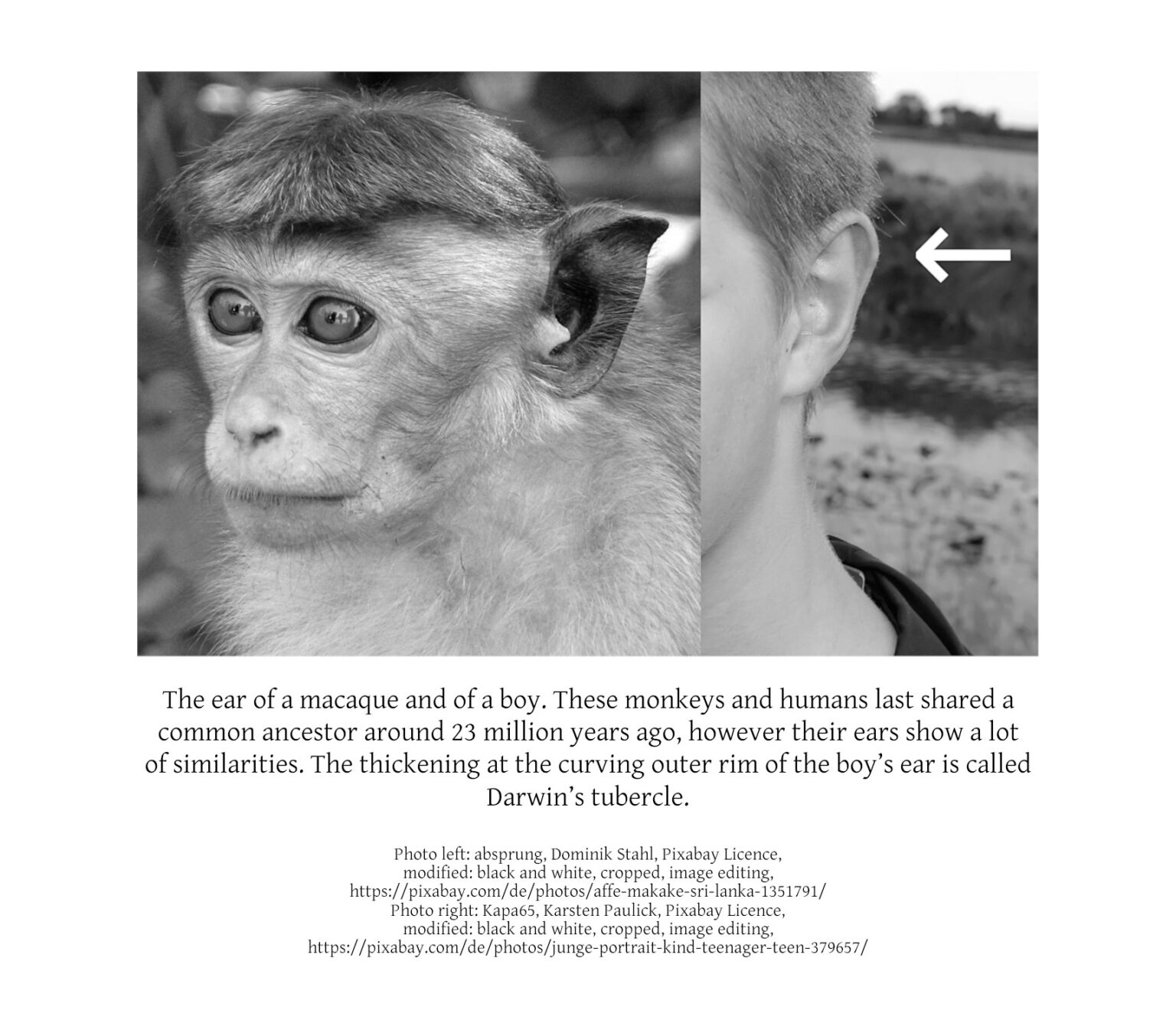
Epilogue about Great Apes
To answer the young readers’ possible questions after reading the novel, Adam the Ape has a scientific epilogue about Great Apes. Here are excerpts:
Among the Great Apes, scientists count four genera, or groups of related species: chimpanzees, gorillas, orangutans, and—what many people don’t know—humans.
(…)
Though there are humans with different skin colors, they are more closely related to each other than other animal species. This is because the most recent ancestors of mankind only migrated out of Africa about 100,000 years ago before spreading across the rest of the world.
(…)
Chimpanzees, gorillas, and orangutans, can communicate within their species. They do this through facial expressions, gestures, and sounds. Only humans have learned to speak aloud with words. This ability has developed after millions of years of adaptation and development within human voice boxes and brains. Humans who cannot speak with words can learn sign language to express anything that can be said vocally.
(…)Great Ape mothers have been observed to adopt orphaned children of their own species; they are helpful and care for others, even if there is no benefit to them. The other Great Ape species have feelings like humans do and express their feelings the same ways. Ape friends hug and kiss each other when they meet. They also calm each other through touch when somebody is frightened. Great Apes, like many other animals, feel pain. When they defend their territory against intruders, the skirmishes can even turn into warlike battles.
(…)
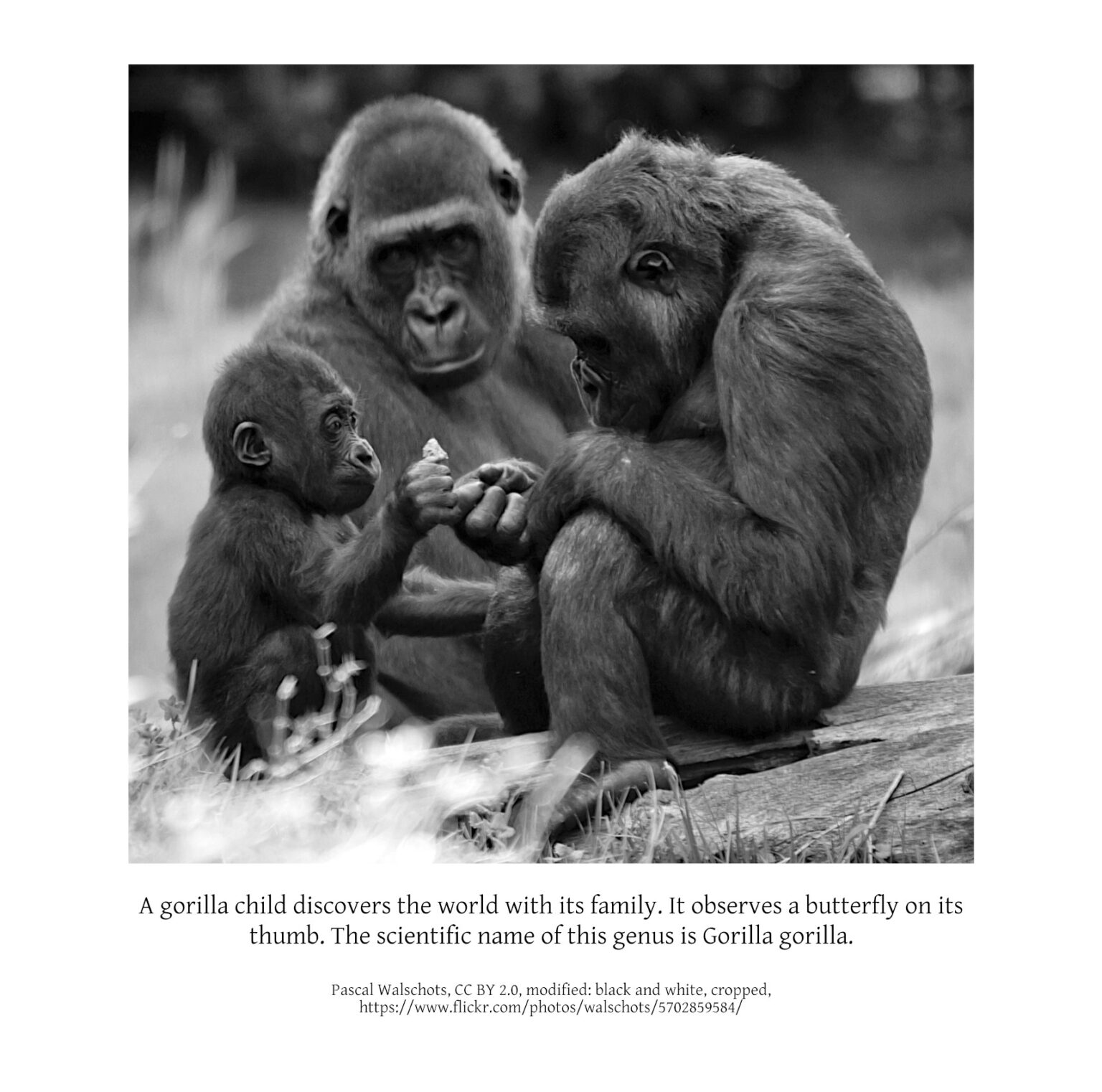
The novel
Kenny is the best player in online adventure games, where nobody realizes he is unable to speak. In real life, the mute schoolboy is bullied and cannot find friends. Everything changes after he meets Adam, a circus ape who can talk through sign language. When the chimpanzee is threatened at the circus, he escapes from his cage, taking Kenny with him. Together, they decide to find the scientist who is said to know the “secret of language.” A thrilling journey across the country begins, on which they surpass even their own expectations. But soon, Adam’s life is in danger. Will Kenny follow his inner voice and fight for his new friend?
An adventure novel for readers from eight to fourteen years old, with illustrations, photos, and scientific epilogues about evolution and Great Apes.
Author: Wolfgang Wambach
Editing: Tamra Gillette
Illustrations: Michael Blechmann
Language: American English
Format: Hardcover A5
ISBN: 978-300071569
